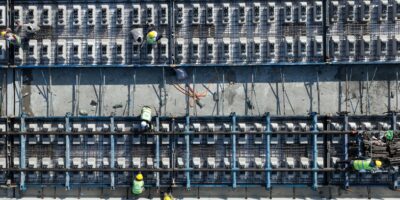
By Cheng Long, People’s Daily
In the satellite images of the Earth at night, a vast expanse of dazzling lights are seen stretching across the Guangdong-Hong Kong-Macao Greater Bay Area, which comprises Hong Kong, Macao, and nine cities in south China’s Guangdong province, including Zhuhai, Guangzhou, Foshan, and Shenzhen.
The Greater Bay Area,with a total area of 56,000 square kilometers and a population of over 80 million, is one of the most open and economically vibrant regions in China.
It has less than 1 percent of China’s land area and 5 percent of the country’s total population, and yet it created 12 percent of the country’s total gross domestic product (GDP).
Since its construction officially began nearly five years ago, the Greater Bay Area has seen its GDP rise about 2.4 trillion yuan ($360.8 billion), demonstrating economic vitality unseen in any other regions in China.
“After the new Hengqin Port, which was built to facilitate travel between Macao and Zhuhai, opened in August 2020, it only takes me less than half an hour to drive from my home in Macao to my office in Guangdong Macao In-depth Cooperation Zone in Hengqin,” said Neildo Choi, a young entrepreneur from Macao who started his business in Hengqin as well as founder of SinoKru Elec Tech Ltd.
As the infrastructure in the Greater Bay Area is improved, a transport network encompassing all relevant 11 cities has been closely knit.
Officially connecting Hong Kong and Macao to China’s expressway network,the Hong Kong-Zhuhai-Macao Bridge has substantially facilitated the travel in the Greater Bay Area.
The operating railways and expressways in the region have achieved a combined length of roughly 2,500 kilometers and 4,972 kilometers, respectively. The road density of the area has increased to 9.1 kilometers per 100 square kilometers.
Thanks to an innovative customs clearance model, self-service customs clearing is available totwo-thirds passengers traveling between Hong Kong, Macao and Guangdong.
World-class airport and port clusters are taking shape at a faster pace in the area; its airports can handle over 200 million passengers annually, and the container throughput of its ports exceeded 80 million twenty-foot equivalent units (TEUs).
Residents are now able to travel between Guangzhou and Foshan, Shenzhen and Hong Kong, and Zhuhai and Macao within about one hour.
“I’ve always wanted to invest in renminbi products of the Chinese mainland, and my wish came true after the Cross-boundary Wealth Management Connect Scheme (WMC) was launched, which allows me to enjoy the benefits of financial connectivity in the Greater Bay Area,” said a Hong Kong resident surnamed Kwong. On Oct. 19, 2021, Kwong became the first customer of the scheme.
As rules and mechanisms are gradually unified in the Greater Bay Area, a new system for an open economy is being built at a higher speed.
From Shenzhen-Hong Kong Stock Connect to Southbound Trading under Bond Connect and to Cross-boundary WMC, from enabling construction engineering companies and professionals from Hong Kong and Macao to carry out business or practice in Guangdong, to cross-border commercial registration handling mechanism, and to formulating the first batch of 70 standards in 23 fields, including food in the Greater Bay Area, it is evident that the area is witnessing greater connectivity concerning its rules and mechanisms.
Research institutes in Hong Kong and Macaocan enjoy the same treatment as their counterparts in the Chinese mainland in Guangdong; Guangdong’s fiscalfunds for research and development can be directly allocated to Hong Kong and Macao institutions; andlarge-scale scientific research equipment can enjoy convenient customs clearance procedures via a 24-hour application platform.
As the cross-border flow of innovation factorsbecomes smoother, Guangdong, Hong Kong and Macao are shifting from cooperation to integration.
“The Greater Bay Area is generating more and more opportunities, and becoming an increasingly big platform,” said Joaquim Vong, a young lawyer from Macao. He co-founded a law firm in Hengqin over two years ago, which now has nearly 70 employees.
As residents in Guangdong, Hong Kong and Macao become more closely connected, a circle of high-quality livingis being formed in the Greater Bay Area.
A policy that allows the children of Hong Kong and Macao residents who are working and living in the nine cities of Guangdong involved in the Greater Bay Areato enjoythe same rights as their mainland counterparts regarding preschool, compulsory, and senior high school education has been implemented; and a pilot project that enables eligible medical institutions in these nine cities of Guangdong to use Hong Kong/Macao-registered drugs and medical devices according to regulations has been launched.
Besides, a policy on a unified social insurance scheme has also been implemented in the Greater Bay Area. As of the end of 2021, a total of 279,200 Hong Kong and Macao residents hadbeen covered by old age insurance, unemployment insurance,and work-related injury compensation insurance in Guangdong.
Guangdong has established a system ofinnovation and entrepreneurship incubation bases for young people from Hong Kong and Macao, incubating more than 2,300 projects and attracting more than 3,400 young people from the two special administrative regions. The number of Hong Kong and Macao residents included in employment registration and management in Guangdong has exceeded 85,100.
By constantly deepening win-win cooperation and promoting high-quality construction of the Greater Bay Area, Guangdong, Hong Kong and Macao are bound to build a vibrant and highly innovative first-class international bay area and a world-class city cluster with optimized industrial structure, smooth flow of various factors, and pleasant ecological environment.










